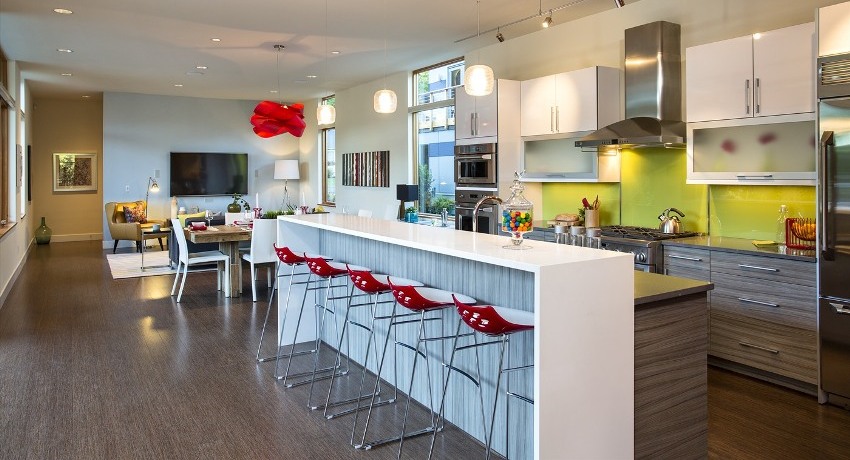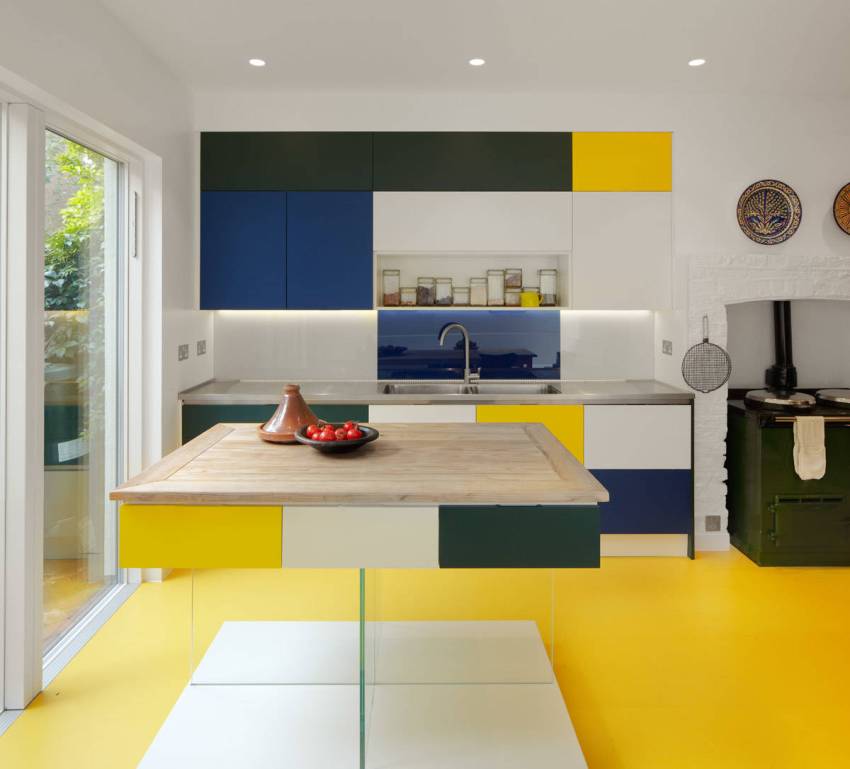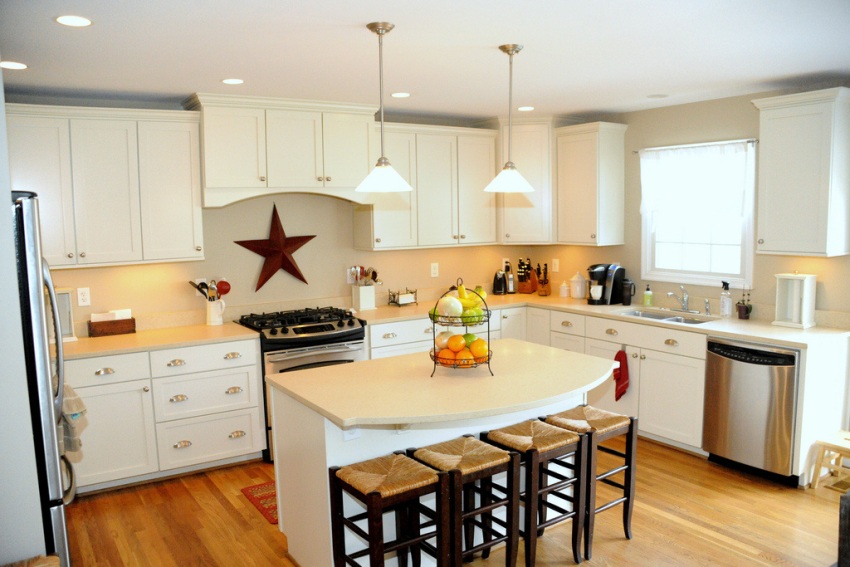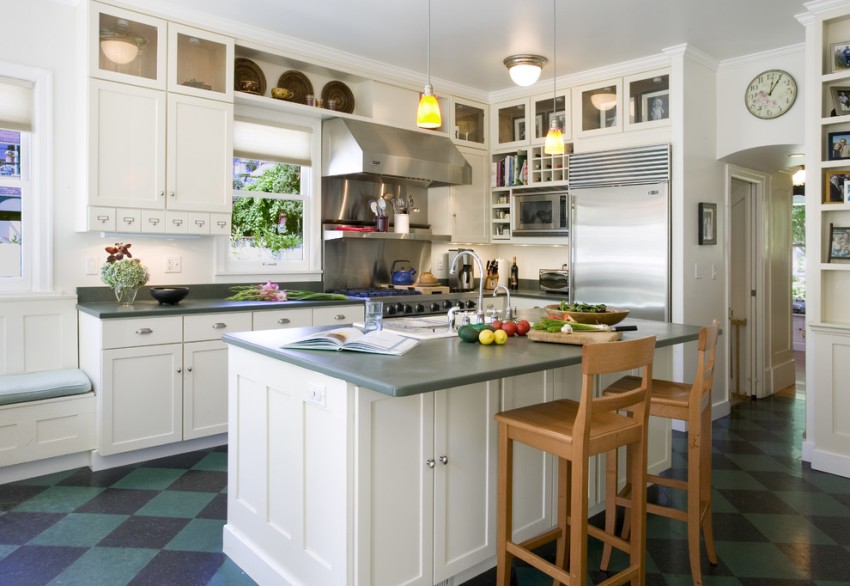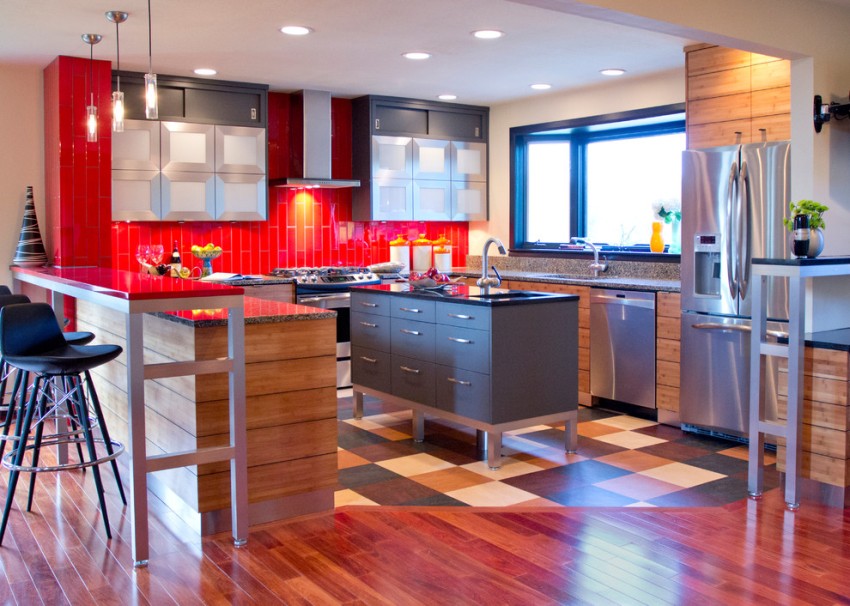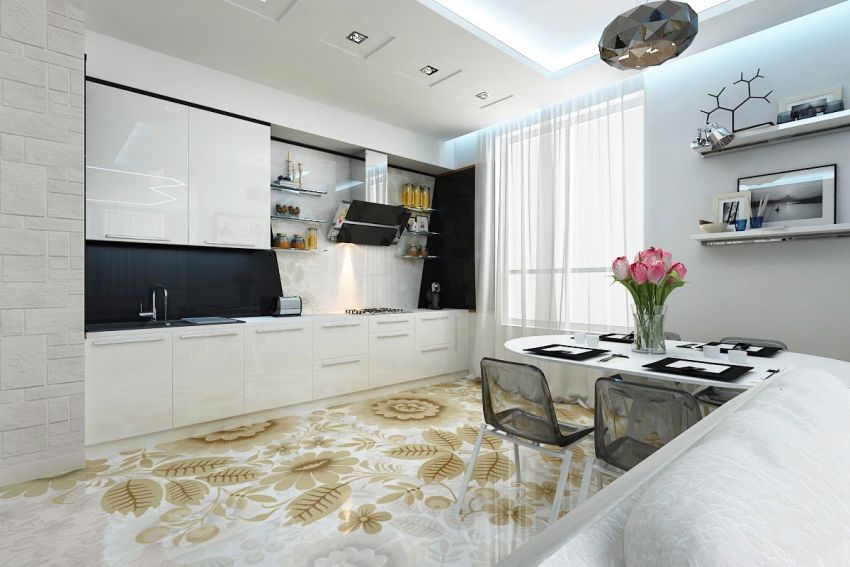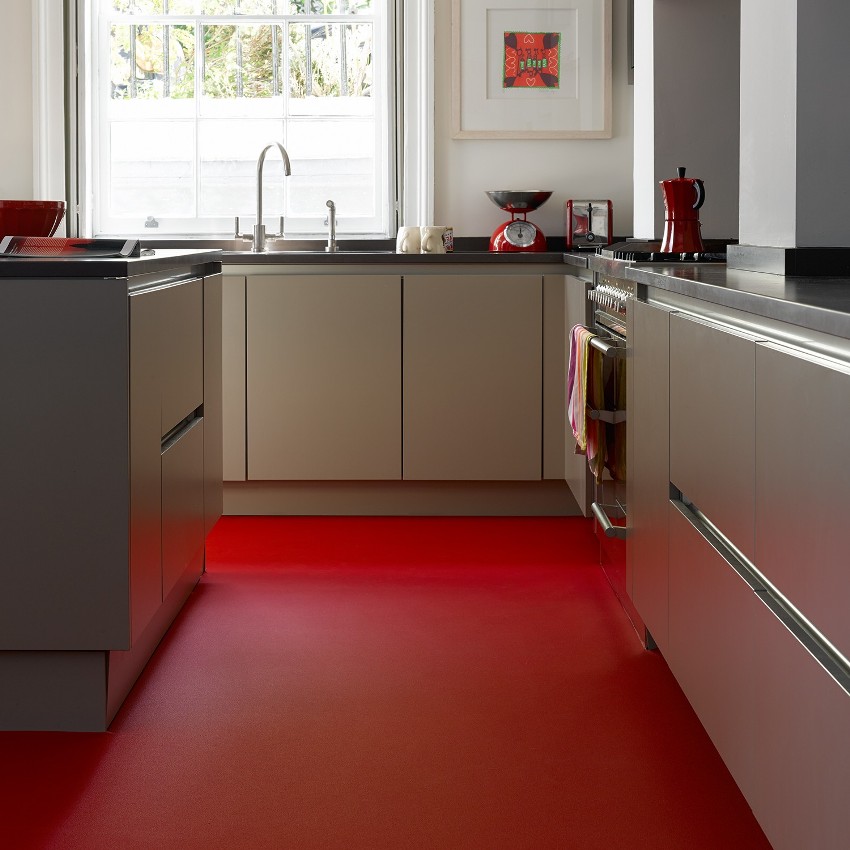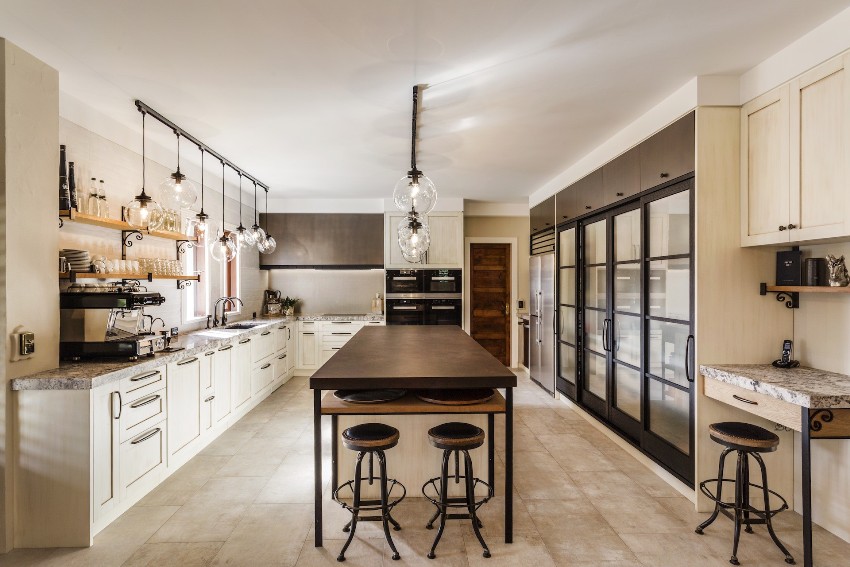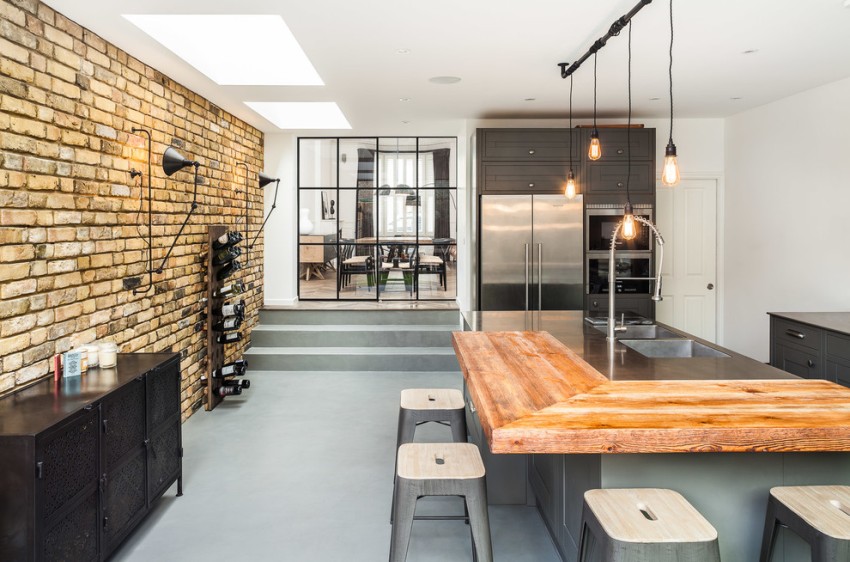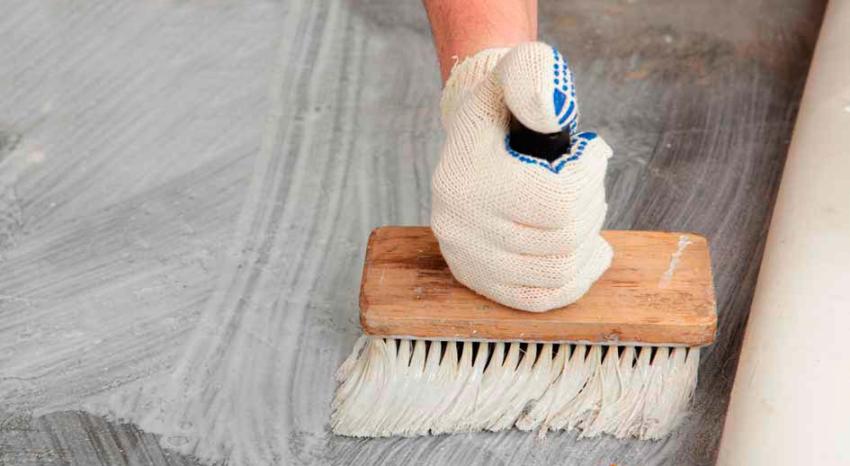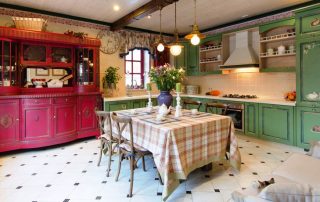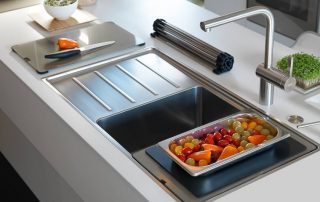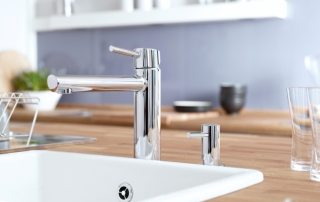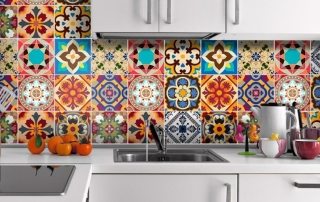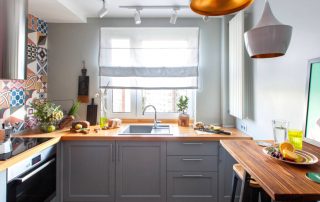Among the various types of floor coverings, linoleum has held a confident leadership for many years. Affordable price, wide range of models, easy styling and ease of care - these are key qualities that underlie consumer choice. It is especially popular in houses and apartments. In this article we will figure out which one is better to choose linoleum for the kitchen, what are the advantages of this type of coating, and in what way it is inferior to tiles and laminate; We will tell you how to install the material and take care of it.
Content [Hide]
- 1 Linoleum in the kitchen: features and varieties
- 2 How to choose linoleum for the kitchen: the refutation of myths
- 3 Which linoleum is better for the kitchen: the choice of model and design
- 4 What is the width of linoleum: calculation and selection of sizes
- 5 Laying linoleum on the floor: rules and features
- 6 Caring for linoleum in the kitchen: the choice of tools and materials
- 7 Manufacturers of linoleum for the kitchen: ratings and reviews
Linoleum in the kitchen: features and varieties
As the most popular option for flooring, linoleum is used in various residential and household rooms, as well as in public institutions. Due to a number of positive qualities, in particular, easy cleaning and water resistance, it is widely used in the kitchen.
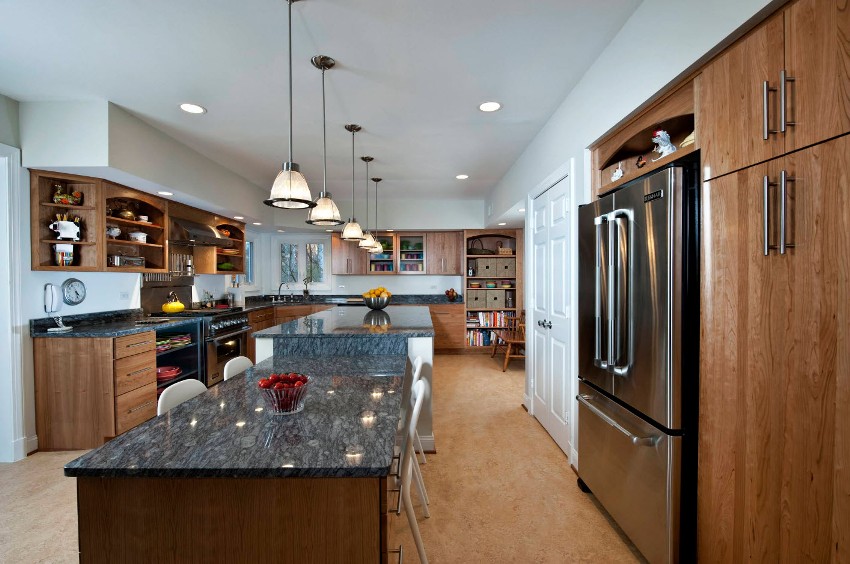
Despite all its availability, linoleum is distinguished by high performance - it is wear-resistant, easy to install, not afraid of moisture
Linoleum entered our life a long time ago. It was invented back in the 19th century in Great Britain as a roll-to-roll finishing manufactory and is used not only as a floor covering, but also for decorating walls.
For a long time, this material was appreciated mainly for its affordability and ease of installation. Currently, modern manufacturers offer the widest range of products. Consumers recognize the material for its beautiful decor, a variety of colors and the ability to choose an unusual texture.
Choosing which linoleum is best for an apartment, zealous owners take into account the fact that a high-quality coating is not afraid of moisture, does not deform under furniture, does not promote the growth of bacteria and is easy to clean. In addition to the above, linoleum, in comparison with moisture resistant parquet and laminate flooring, is much cheaper, which makes it indispensable in the kitchen.
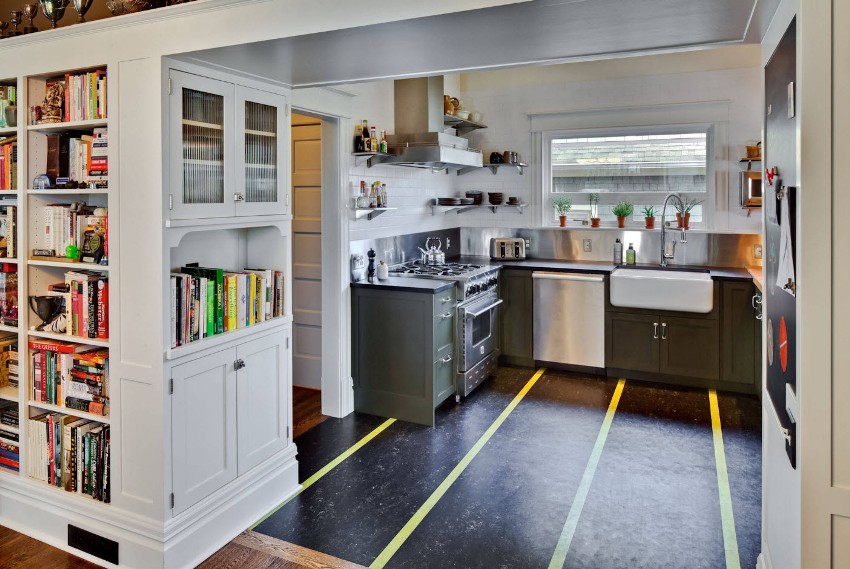
Linoleum must withstand many factors that test it for durability, shock resistance, water resistance, heat resistance
Which linoleum to choose for an apartment: natural or artificial turf
Before deciding which linoleum choose for the kitchen, you need to get acquainted with its types. Depending on the material, it can be natural or artificial.
For the production of natural flooring, linseed oil, wood and cork flour, lime powder, resins and natural pigments are used. Natural fabric or non-woven materials are taken as a basis. The main qualities of such linoleum are environmental friendliness, hygiene in use and durability (up to 40 years of operation).
The natural coating has a special protective layer that forms linseed oil. This substance is a powerful natural antiseptic that not only protects the coating from germs, fungi and bacteria, but also helps to disinfect the air in the kitchen. It should be noted that this bactericidal effect lasts throughout the entire life of the coating.
Important! The main disadvantage of natural linoleum is its high price, which is several times higher than the cost of a synthetic analogue.
The strongest kitchen pollution, fire and aggressive household chemicals are not afraid of the natural coating. It has good heat and sound insulation. In terms of positive properties, such a material is almost as good as natural cork flooring.
In the production of artificial linoleum, polyvinyl chloride is used, which has the qualities of a natural coating, but serves much less. PVC linoleum made in accordance with GOST and European EN standards is generally odorless and environmentally friendly.
Manufacturers of artificial linoleum have taken care of its safety. For this purpose, PVC coatings are treated with special antibacterial agents. Thus, a specially created layer prevents the growth of bacteria. In addition, such properties help protect households from infectious diseases. High-quality artificial linoleum has an additional antifungal impregnation, but such properties weaken over time.
Which linoleum is better to choose for an apartment: material structure
Depending on the structure of the coating, linoleum can be homogeneous or heterogeneous. Homogeneous has one layer, which is uniform in composition, color and has a thickness of up to 3 mm. This type of coating is not very popular, as it has a meager supply of decorative patterns and colors. At the same time, it has a number of undeniable advantages:
- uniformity of the coating guarantees strength and elasticity, prevents delamination;
- due to the roughness, the surface does not slip, dust and dirt are less visible on it;
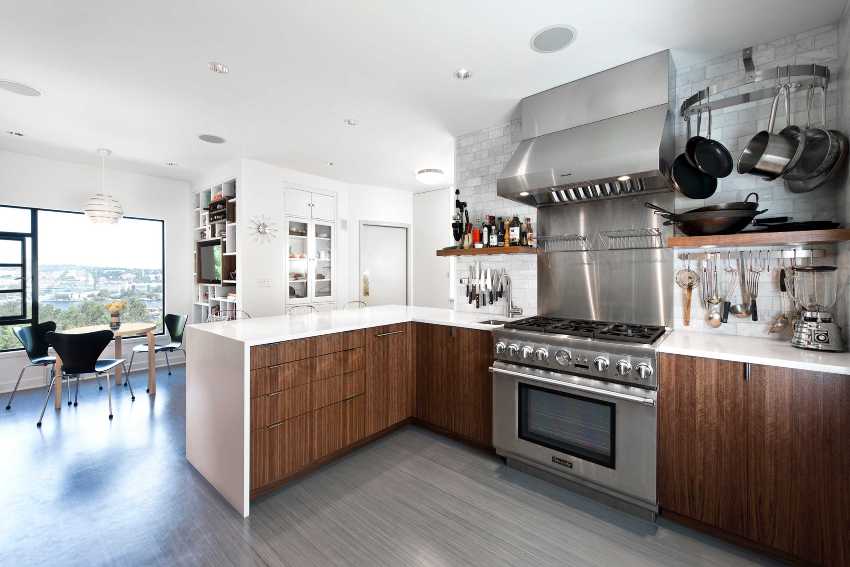
For the kitchen, it is best to buy commercial or semi-commercial grade linoleum, since it has a high degree of wear resistance
- the pattern, which penetrates the material throughout the entire thickness, retains the presentable appearance of linoleum.
The structure of a standard heterogeneous linoleum has several layers:
- dense polyvinyl chloride backing provides sound and thermal insulation;
- glass canvas from fiberglass makes the surface smooth or, conversely, rough;
- layer with a pattern, or decorative;
- protective ball;
- high density polyurethane layer provides additional protection.
The thickness of heterogeneous linoleum is up to 6 mm. This option is more popular as a kitchen cover.
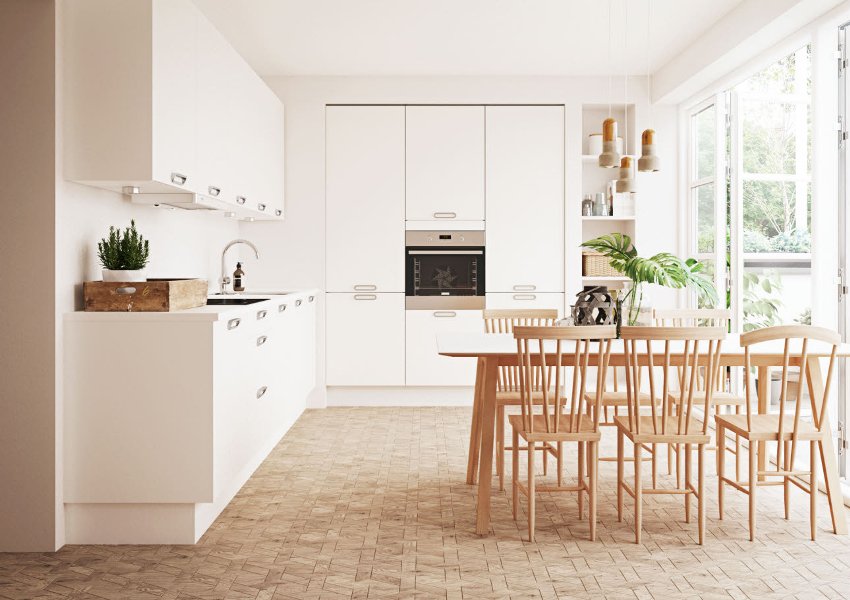
It is not worth saving and buying cheap coatings, as they may contain toxic substances due to violations of production technology
When deciding which linoleum to choose for the house, preference should be given to polyvinyl chloride. Colloxive material, although durable, is highly flammable, so it is prohibited in residential premises. Glyphthal linoleum is not resistant to temperature extremes, and the positive qualities of the rubber coating are suitable for warehouse, industrial and sports premises, but not for the kitchen.
PVC linoleum has varieties. Depending on the permeability of the premises and wear resistance, the coating is divided into household, commercial and semi-commercial. For a kitchen with a heavy load, it is worth choosing a material with a durable protective layer having a thickness of 0.35 to 0.7 mm. In this case, semi-commercial or even commercial heterogeneous linoleum is suitable.
Helpful advice! A simple rule will help in choosing a coating for the kitchen: the heavier the linoleum, the higher the density, which means that it has better characteristics and will last much longer.
How to choose linoleum for the kitchen: refutation of myths
Low-quality products, unpleasant experiences and rudiments of the last century contributed to the generation of a number of myths about linoleum, in particular:
- The floor on which the linoleum is laid has an unpleasant smell. This myth refutes most of the rating modern manufacturers who use high-quality materials in the manufacture of coatings that are practically odorless and have no harmful emissions.
- Over time, spots appear on the surface of linoleum in places of greatest passability. Such a minus really has a household linoleum class, commercial and semi-commercial types are mostly resistant to the aggressive effects of household chemicals and even after several years of use do not have scuffs.
- Thick linoleum will last longer. The statement is not entirely correct, as commercial and semi-commercial coatings are usually thicker than household ones. You should know that transparency plays an important role in wear resistance, that is, a protective layer, the thickness of which must exceed 0.5 mm.
- Seams diverge between the strips of linoleum. In modern construction, this problem is no longer relevant, since special strips are applied to the seams, and in the kitchen, for the purpose of hygiene, as a rule, a solid canvas is used.
- Mold can form under the linoleum. Correctly laid covering excludes the formation of fungus, especially if it is artificial, with an upper moisture-proof layer. Even during flooding, you just need to bend the raw part of the linoleum and let it dry. In the event that you are often flooded by neighbors or pipes are leaking, it is better to choose a tile.
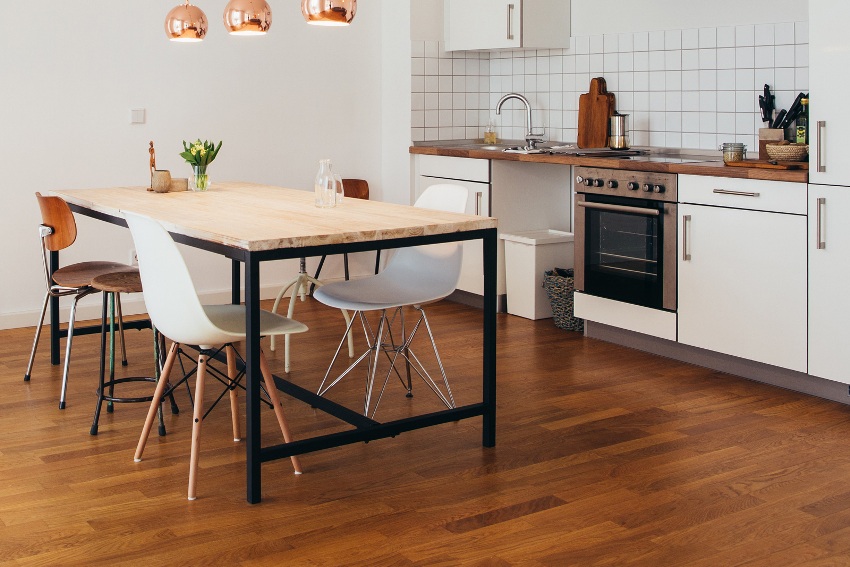
Linoleum on the kitchen floor is the most budgetary option, which is often resorted to not only because of its cheapness, but also because it is easy to lay
Abrasion groups and wear resistance class of linoleum
In such a matter of how to choose the right linoleum, in addition to the type of coating, you need to take into account its abrasion and wear resistance, which are the main quality criteria.
According to the European certificate EN660-1, abrasion is defined as the degree of wear of the upper protective layers under the influence of an abrasive wheel in a certain mode. Groups, of which there are only four, are designated by Latin letters, where:
- F - the lowest degree of wear resistance of a surface with high abrasion (thickness variation from 0.3 to 0.6 mm);
- M - low level of wear resistance with a moderate change in layer size (from 0.15 to 0.3 mm);
- P - average degree of wear resistance with low surface abrasion (from 0.08 to 0.15 mm);
- T - the most durable layer with a change in thickness up to 0.08 mm.
The level of wear resistance is also determined according to a special European classification EN685.Such marking consists not of their letters, but of two numbers, where the first indicates the type of room, and the second indicates the level of permissible load on the coating. It is these classes that share coverage as follows:
- household with numbers 21-23 (for living rooms);
Related article:
Waterproof laminate for the kitchen: all about quality coating
Distinctive parameters of moisture-resistant material, advice on choosing a high-quality flooring, prices for good products.
- semi-commercial - 31-34 (for public premises);
- commercial - 41-43 (industrial areas).
Helpful advice! For the kitchen, you need to choose a coating of at least 23 class. The best option is class 32 linoleum.
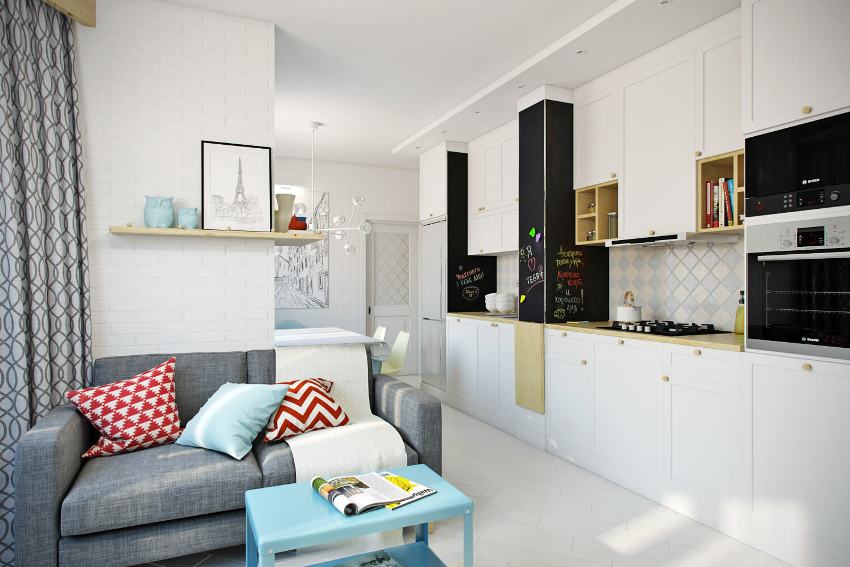
The wear resistance class of linoleum can be found on the reverse side of the canvas in the form of icons or pictures
Tile, linoleum or laminate: which is better in an apartment
Most often in the kitchen, linoleum is used as a floor covering, nevertheless, many owners prefer tiles or laminate. In the question which is better - laminate or linoleum, expert opinions lean towards the latter, highlighting its such advantages:
- The durability of linoleum (the service life of natural - over 40 years, artificial - up to 15). Laminate flooring lasts up to 10 years.
- Linoleum is easy to clean. With the help of detergents, you can literally clean all stains, but it is quite difficult to remove traces of beetroot juice or red wine from the laminate.
- PVC cover is suitable for apartments with pets. If pet food or excrement gets trapped in the laminate flooring, it can be difficult to remove.
- Thermal and acoustic insulation of laminate and tiles is much lower, while felt-based linoleum creates additional heat and is practically silent.
In terms of cost, linoleum also wins, the price for 1 sq. m which ranges from 150 to 800 rubles. An acceptable option for a kitchen costs approximately 350 rubles per square meter. The cost of laying linoleum, in comparison with tiles, laminate, parquet board or self-leveling floor, is more affordable. Such a covering can be laid with your own hands, and it is even easier to dismantle it.
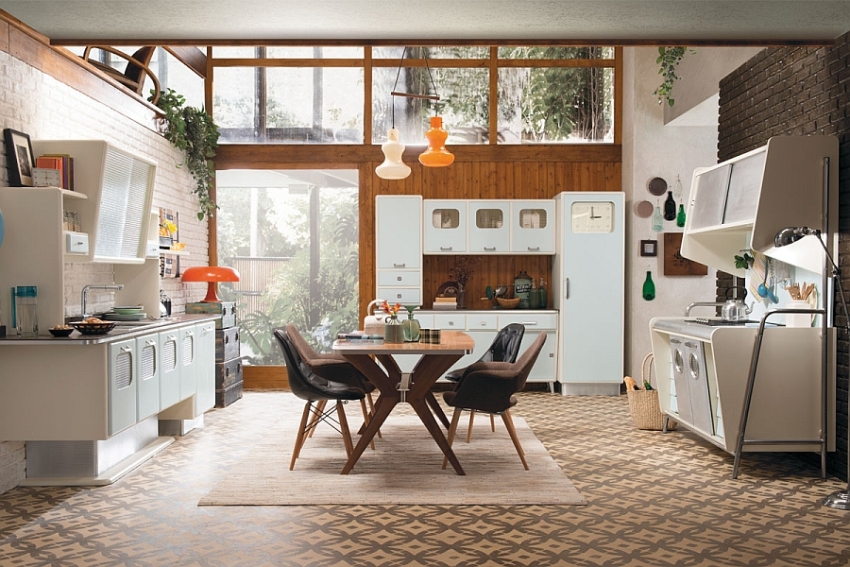
The choice of flooring for the kitchen depends on many factors: budget, operating conditions, and the characteristics of the room itself
It is worth noting that laminate is an artificial material, so it is generally difficult to compare it with natural linoleum. In addition, laminate flooring in the kitchen requires an additional protective coating. At the same time, most linoleum models already have it. Both types of flooring materials can imitate a variety of surfaces - from wood to stone. Thus, laminate flooring has several disadvantages compared to linoleum. It is unnatural, short-lived, less moisture-resistant and not shock-resistant.
What's better – laminate or linoleum: reviews buyers
Consumers in their reviews on forums and construction sites prefer different materials. At the same time, linoleum is characterized as a wear-resistant coating that can withstand impacts from falling sharp and heavy objects. In addition, a modern high-quality PVC coating in color and texture can perfectly imitate linoleum under parquet or wooden floor. There are options for tiles, leather or stone. The color and textural diversity is evidenced by photos of linoleum in the interior, posted by consumers on the network.
Pointing to the mass of advantages of linoleum, users also mention its disadvantages, in particular:
- dents may appear on the coating from furniture, which excludes options for rearrangement in the kitchen;
- artificial type of coating - natural materials look more solid;
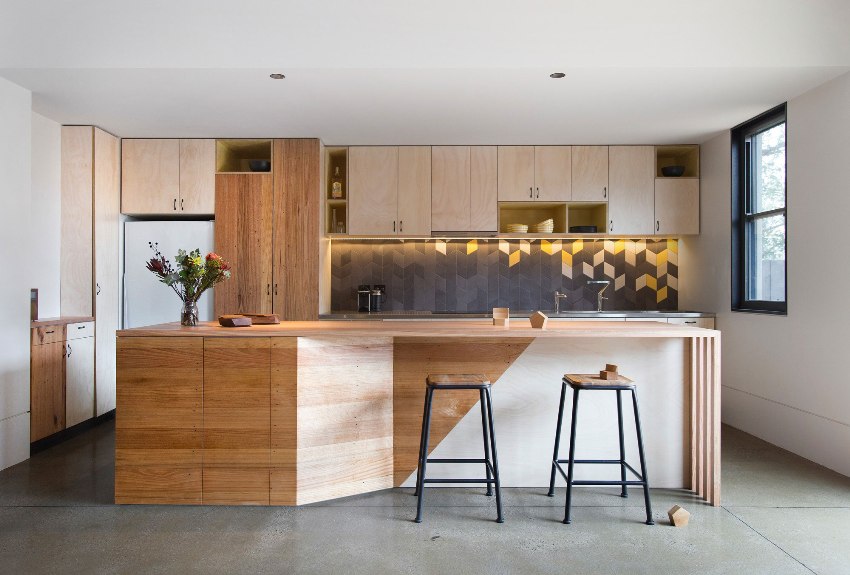
Both types of flooring, laminate and linoleum, are understandably popular due to their affordability.
- as a result of improper installation, the coating can deform, "float" and wear out faster;
- at the junction of the pieces, traces from the joints are often noticeable, and gaps can also form at the seams.
Thus, the laminate, although slightly, is inferior to linoleum, in particular as a floor covering for the kitchen.
Helpful advice! You should not immediately unfold the roll when buying linoleum if the air temperature is below 10 ° C. It should be rolled up at room temperature for a couple of days. Otherwise, during the installation process, it may simply crack.
Which linoleum is best for the kitchen: choice of model and design
Based on the above, kitchen flooring should be durable, durable, reliable, easy to maintain, and resistant to chemicals. In order to prevent injury, the kitchen floor should not be slippery. Many consumers prefer ceramic tiles precisely because of these listed qualities. Buyers often choose laminate flooring.
Serious competition for both laminate and tile is modern high-quality linoleum. A lot of people are thinking about which coating to choose for the kitchen - linoleum under the tiles or under the laminate. Modern manufacturers offer many models with the appropriate pattern and color of linoleum made from natural and synthetic materials. Which option to choose is up to the consumer, the main thing is that the floor covering matches the overall design and interior of the kitchen.
For the kitchen floor, both matte and glossy linoleum is suitable. The gloss is easier to clean, but the surface is more slippery. The range of this flooring consists of colors and textures that imitate various materials, including:
- classic beige and brown tones of wood-like linoleum;
- models imitating natural stone or ceramic tiles;
- mosaic or parquet images;
- fantastic texture with abstract patterns and the same pattern;
- one-color coatings;
- textured models with imitation of laminate;
- linoleum under the tile.
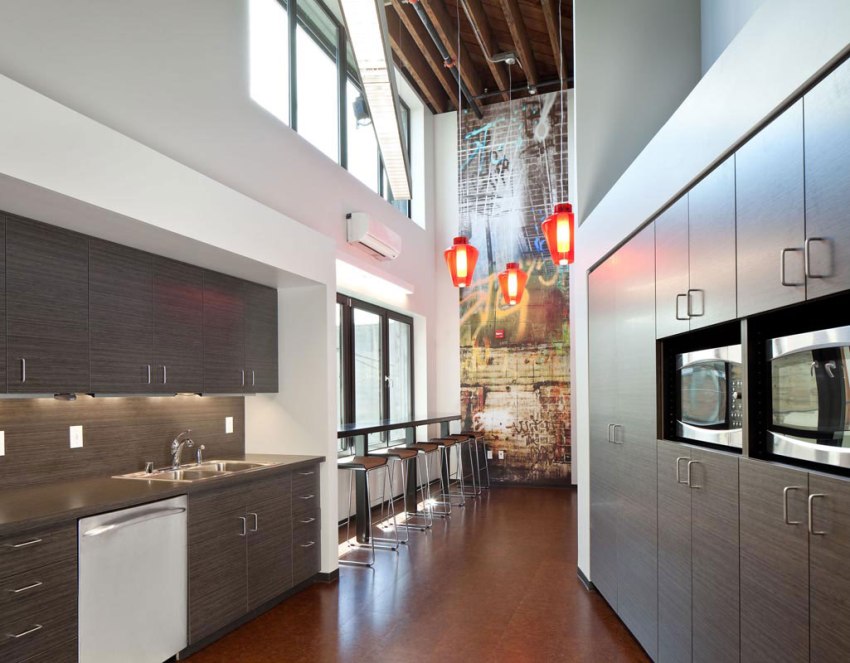
You can find a huge number of colors and patterns of linoleum, moreover, most of these coatings do not fade over time.
Linoleum for tiles: options for the kitchen
There are several reasons why consumers should buy linoleum for the kitchen with a pattern for the tile, and not the tile itself. Let's consider each of them.
- Choosing a classic pattern for a tile is quite simple. At the same time, it will become a full-fledged element in the decor of the room, fulfilling its direct purpose and delighting with all the advantages of linoleum as a floor covering. Photos of linoleum in the kitchen under the tiles clearly indicate its aesthetic appeal.
- Linoleum is easy to maintain. The hostess does not have to think about how to wash the linoleum in the kitchen - just use ordinary detergents. And the tile requires additional cleaning and renewal of the seams.
- Modern linoleum, as a rule, is covered with a special anti-slip coating, which guarantees slip protection even on a wet surface. Unfortunately, ceramic tiles do not have such properties.
- Linoleum resists deformation well, while maintaining its original beauty.
- Linoleum flooring is much warmer and more pleasant than cold and slippery tiles.
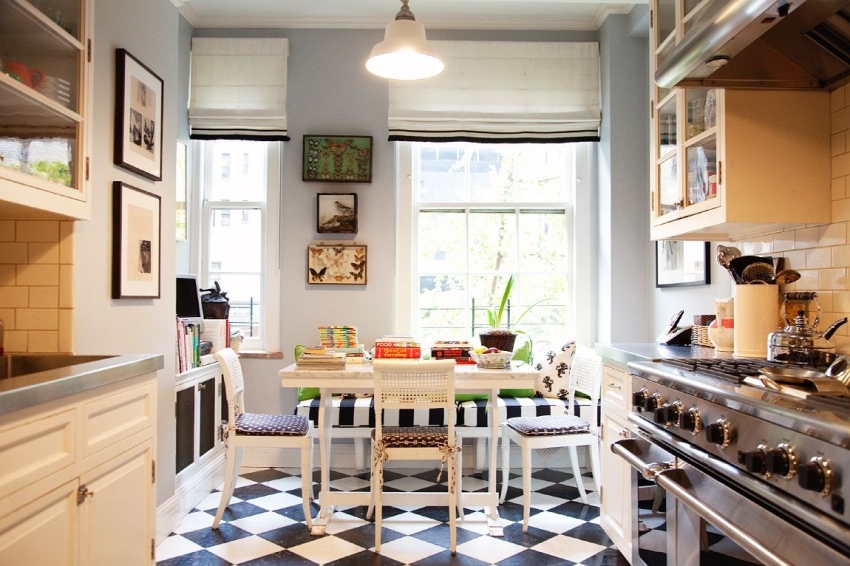
Linoleum for tiles can be called a traditional option, because it creates a modern and classic indoor environment
Helpful advice! For long-term preservation of the attractiveness of the floor, it is better to buy semi-commercial Tarkett linoleum with a "tiled" pattern. Such a coating will perfectly fit into the overall style of the kitchen interior design.
Linoleum for laminate: features and benefits
Linoleum with imitation laminate is a special coating that consists of several layers, with a pattern that imitates laminate panels.The material, in comparison with conventional laminate, has a number of features. The main advantage is that, subject to the correct choice and installation, it practically does not differ from the laminate, while having better performance characteristics in terms of operation.
In addition, it is easier to lay linoleum using special glue, and it will take much more time to lay laminate panels using special locks. It is important to note that the coating under the laminate is laid in pieces, and not in one sheet, which makes it possible to imitate the laminate flooring as perfectly as possible.
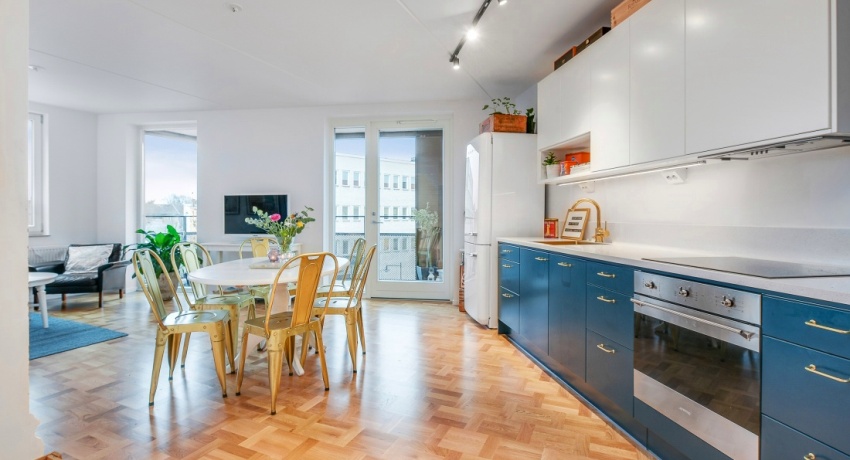
Modern types of linoleum have an extremely attractive appearance, differ little in appearance from a good laminate, but at the same time they are not at all afraid of water
Linoleum floors do not fade for a long time and do not deform, have a longer service life. This is the best option for a room with a "warm floor" system. Photos of linoleum under the laminate also indicate a wide range of models with different textures and colors. The main advantage of linoleum is its lower price. In combination, the listed advantages persuade consumers to choose linoleum as a floor covering.
Linoleum for the kitchen: styling
When choosing the color of linoleum, it should be borne in mind that dust, stains and crumbs will be quite noticeable on a dark and too light floor. The best color options are brown and gray. The dark coating visually conceals the space, therefore it is suitable exclusively for spacious and light kitchens.
At present, drawing under an aged board is especially popular. It is perfect for rooms decorated in a variety of styles: rustic, classic, Scandinavian and loft. In a classic interior, it is better to choose a reliable imitation for ceramics.
High-tech and minimalist kitchens are ideally suited to plain linoleum in cold or contrasting colors. Covering with bright colors or with volumetric geometric patterns is applicable in spacious rooms decorated in Scandinavian style, eclecticism or pop art. Light linoleum of cold shades will help to visually increase the space. Warm flooring makes the kitchen more comfortable, while bright and contrasting colors add dynamism to the room.
Linoleum decor is in great demand, simulating the technique of marquetry. This is a wood mosaic made of various types of veneer. Linoleum covering, which imitates a massive board, looks good in the kitchen interior.
Designers advise courageous and extraordinary people to choose fancy colors with unusual decors, and those who like experiments - models with original geometric or abstract designs. Linoleum under a stone (marble or granite) looks very impressive and unusual.
Helpful advice! When choosing linoleum for a kitchen that has a small size, one rule applies: transverse stripes on the floor contribute to the visual expansion of the kitchen, and vertical stripes contribute to its visual lengthening.
You should not buy furniture of the same shade as linoleum, otherwise you will get the feeling that it "grew out of the floor." The same principle applies to walls, curtains and other objects that are directly adjacent to the floor.
What is the width of linoleum: calculation and selection of sizes
Modern manufacturers offer linoleum in a wide variety of sizes. It can be wide or narrow, thick or thin. It is produced in rolls of different lengths and widths or in the form of tiles.
The length of linoleum rolls ranges from 6 to 45 meters, the width is from 2 to 5 meters in half a meter increments.Some manufacturers, as an exception, produce linoleum 6 meters wide, but such dimensions are typical for production areas, therefore, for the most spacious kitchens, the maximum linoleum width is 5 meters. Such a variety of coating widths allows you to select it with maximum savings in cutting and avoid seams.
The width of the linoleum is chosen depending on the size of the kitchen. The room should be measured before buying. To do this, measure the maximum width and length of the floor. Niches, window and door openings are measured separately. It is advisable to add 8 cm to each measurement, which will take into account irregularities and create a margin for possible shrinkage of linoleum.
For example, for a kitchen of 4 × 2.5 m, it is more profitable to purchase a covering with a 3-meter width (including the stock) and a length of 4.1. This option will allow you to lay the linoleum in one piece without seams. Another option for such an area is linoleum 4.5 meters wide and 2.6 meters long. It should be borne in mind that this choice will cost more, since the price of linoleum per square meter depends on the width of the roll: the wider, the more expensive.
When choosing large rolls, it is necessary to take into account that it may not fit on staircases and elevators, and may not pass when turning from one room to another. Transportation of such a coating is problematic, so it is better to buy such linoleum with delivery.
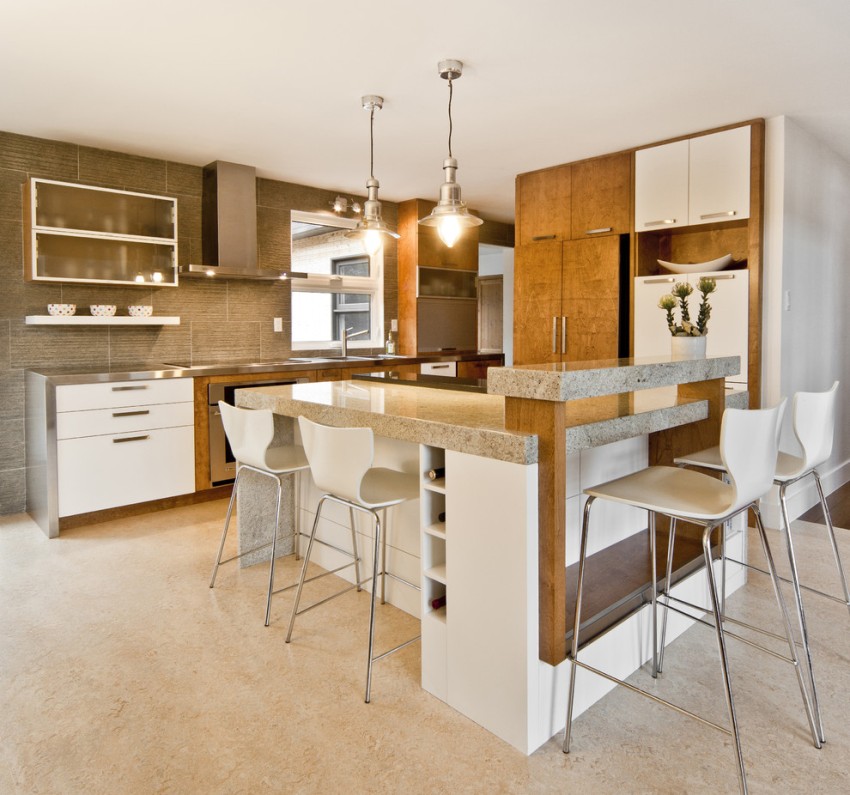
When purchasing linoleum, you should pay attention not only to its color, the quality of the substrate and the thickness of the top layer, but also to the width
Laying linoleum on the floor: rules and features
Linoleum is perhaps the most versatile flooring. It is practical, durable and inexpensive. In addition, this material is quite simple to install. Even a beginner who has previously studied all the styling features can do this.
The linoleum laying technology has its own specific features. In particular, professional construction tools should be used to securely fix the floor covering, make it even and maximize its lifespan. To lay linoleum on a wooden floor, it is necessary to pre-level the floor. This can be done with plywood, chipboard or fiberboard.
Do-it-yourself linoleum laying includes successive stages of work. First, dismantle the old coating or clean the surface if they plan to lay linoleum on top. It is very important to carefully remove all construction debris and dust.
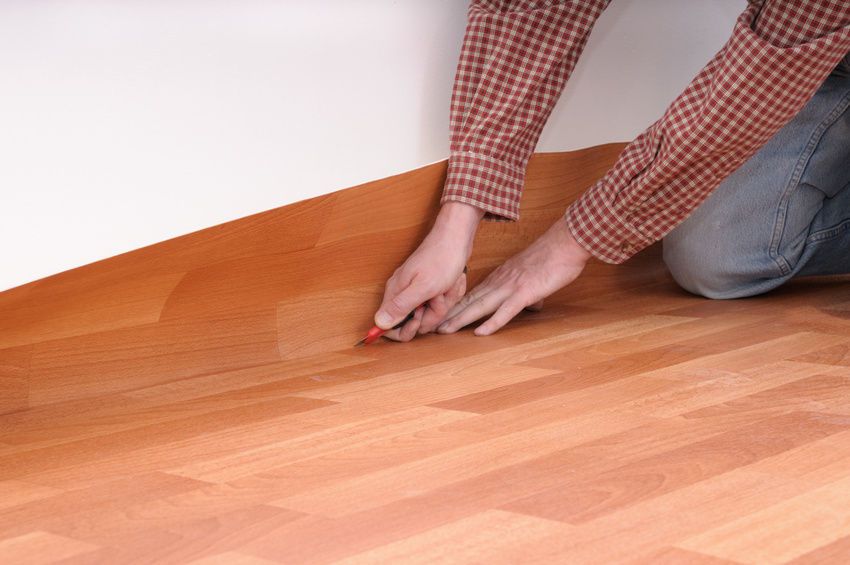
When cutting linoleum, take into account the direction of the pattern and the coincidence of its elements on the combined strips
Helpful advice! Linoleum must be acclimatized before installation. To do this, the roll is brought into the room with a ready-made base. In this case, the temperature in the room should be above 15 ° C. In such conditions, linoleum is left for a couple of days.
This is followed by one of the most time-consuming stages - leveling the floor, sealing cracks, laying the substrate. To level the floor with your own hands, it is best to use a self-leveling self-leveling mixture. The screed must be allowed time to dry completely.
Linoleum is unrolled and left for some time to level. After that, it is cut off, for which it is necessary to use a special, very sharp construction knife. With its help, it is quite easy to cut the material; the markings on the reverse side will help to make even cuts along and across. Do not forget about the technological gaps, which between the coating and the wall should be at least 5 mm.
The next step is to fix the linoleum. To do this, it is glued with special glue over the entire area. You can use a faster method of fastening using double-sided tape around the perimeter. The final fixation of the material is provided by the skirting boards.
Professional installation of linoleum: prices for installation
If you have doubts about your own abilities, if the floor surface is difficult to level yourself, or the room has many recesses, then it is recommended to entrust the work on linoleum flooring to professionals. They take a responsible approach to each stage and, in addition, if necessary, can carry out gluing of joints using cold or hot welding.
Specialists accurately and efficiently carry out styling linoleum on a substrate or a concrete floor, while using modern technologies and high-quality consumables. In addition, experts can provide advice even before laying linoleum. The price of services is calculated taking into account the total amount of work and taking into account how much linoleum costs per square meter.
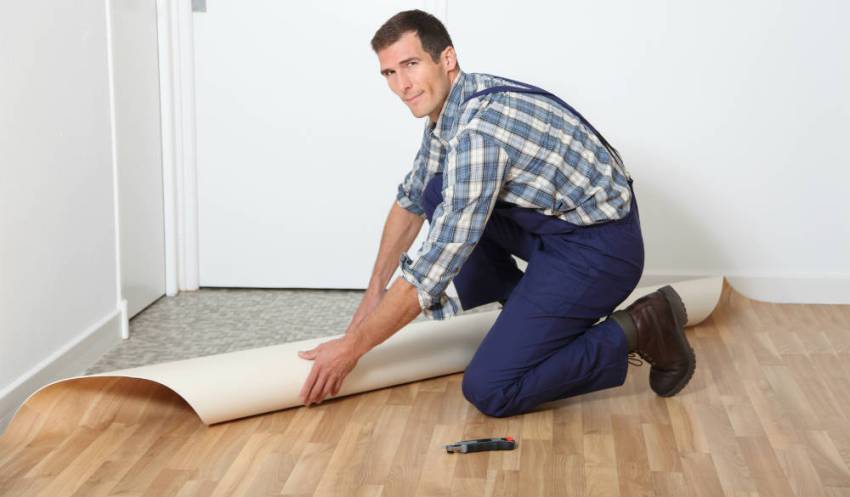
Laying linoleum requires compliance with a number of important rules, so the best option for this is not independent unprofessional work.
The list of services usually includes:
- dismantling of the old coating;
- cleaning and leveling the surface;
- laying linoleum without an adhesive base (technology for installing a natural coating) or laying the coating with mastic or glue.
To the list of basic or additional services, workers also include fixing skirting boards.
In order to independently calculate how much linoleum laying costs per square meter, it is necessary to take into account the entire scope of work, which includes the departure of the master, taking measurements and assistance in purchasing materials. Today the average price is 150-250 rubles. per m².
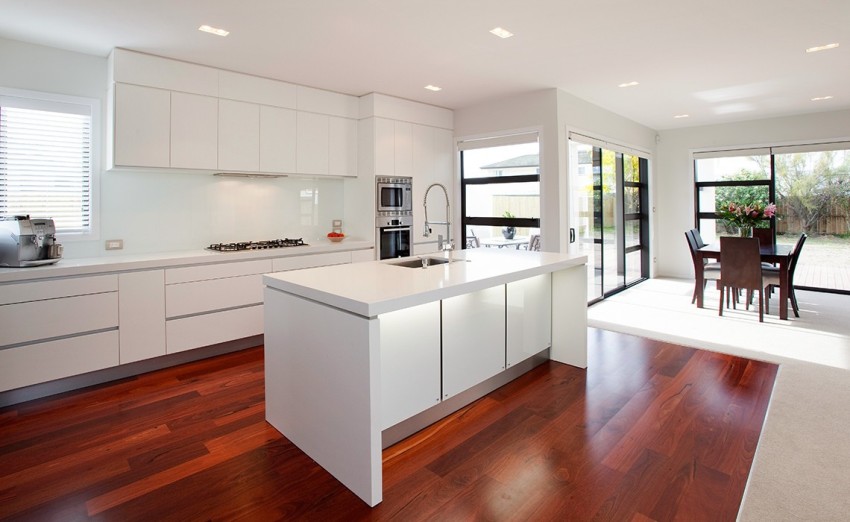
The prices for laying linoleum are completely different, it all depends on the company offering this type of service
Caring for linoleum in the kitchen: the choice of tools and materials
One of the main advantages of using linoleum in the kitchen is ease of maintenance. The hostess does not have to think about how to wash the linoleum in the kitchen, since classic detergents are suitable. At the same time, given that kitchen surfaces become clogged faster, floor maintenance should be systematic and regular.
Save linoleum a protective layer helps from excessive contamination, which, as a rule, is laid by the manufacturers themselves. The special protection can be applied to the floor once or twice a year. This measure significantly extends the life of the material and helps to repel grease and dirt.
Helpful advice! You can use a solution of regular baking soda and detergent for cleaning. The ingredients are mixed in proportions 1: 1 (a tablespoon of each), filled with water. Next, use a brush to clean the surface. A vinegar solution is used to scrub the floor and give the surface a shine.
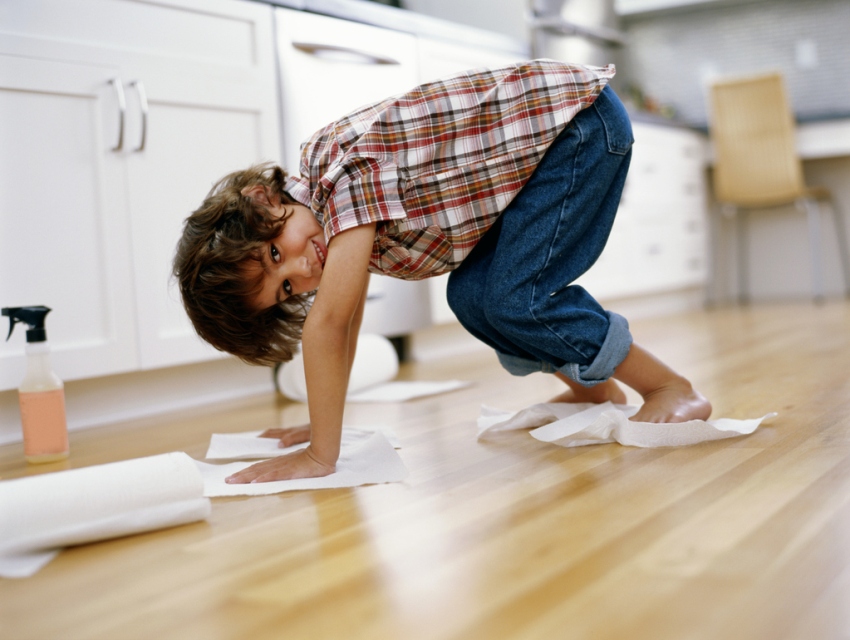
Linoleum is unpretentious to maintain, the kitchen can be easily cleaned with it even from complex dirt
It is enough to carry out such a simple procedure once a month, taking into account the fact that the floors are washed in the usual way as they become dirty, but at least once a week. Proper care of linoleum flooring will significantly extend its life.
Manufacturers of linoleum for the kitchen: ratings and reviews
In the domestic market of linoleum manufacturers, companies such as TARKETT, ARMSTRONG-DLW, FORBO, GERFLOR, JUTEKS, Upofloor, SOMMER, GRABOFLOOR have long and well established themselves. In choosing a manufacturer, one should be guided not only by the websites of companies, but also by consumer reviews.
The most popular according to these criteria is Tarkett linoleum. The photos clearly demonstrate the variety of his models, which are used in the most stylish and sophisticated interiors. The firm produces linoleum of two trade marks - "Tarkett" and "Sinteros". Customer reviews note the density and durability of such a floor covering. In fairness, it should be noted that Tarkett is a quality manufacturer, but far from the only one of its kind.
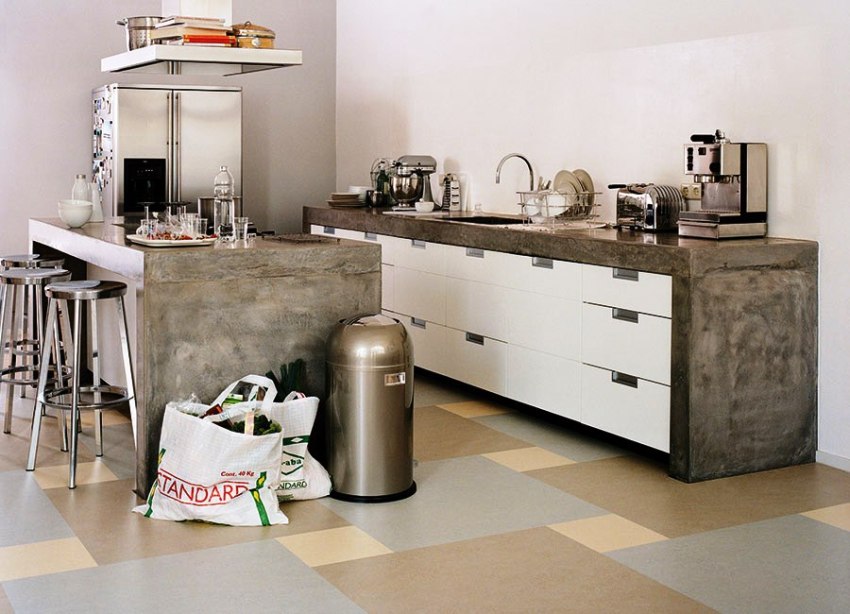
One of the first advantages of Tarkett linoleum is its ease of installation, in addition, it is reliable and belongs to the category of warm coating
In deciding which linoleum to choose for the kitchen, one should take into account the different features of the coating and its advantages. At the same time, it is not worth saving, since it is in the kitchen that linoleum is exposed to heavy loads and pollution. Choosing the right model, color and texture is no longer a problem thanks to the widest range of linoleum, which is rightfully considered the most popular floor covering.
